Risk Management and Financial Analysis: JP Morgan Chase Report
VerifiedAdded on 2022/09/18
|7
|1166
|23
Report
AI Summary
This report provides a financial analysis of JP Morgan Chase & Company, examining its performance and risk management strategies based on information from their 2017 and 2018 annual reports. The report begins with an overview of the company, followed by an analysis of key balance sheet information, including loans, assets, deposits, and equity, highlighting trends and growth rates. The analysis reveals the company's financial position and identifies areas of growth and potential concern. Furthermore, the report assesses the various risks assumed by JP Morgan Chase, such as operational, credit, and interest rate risks, as well as the strategies they employ to mitigate these risks. The conclusion summarizes the company's financial health, sustainability, and risk management practices, underscoring its good financial position and efficient strategies to hedge against risks, with the caveat of a recent decrease in net worth. This assignment is available on Desklib, a platform that provides study resources for students.
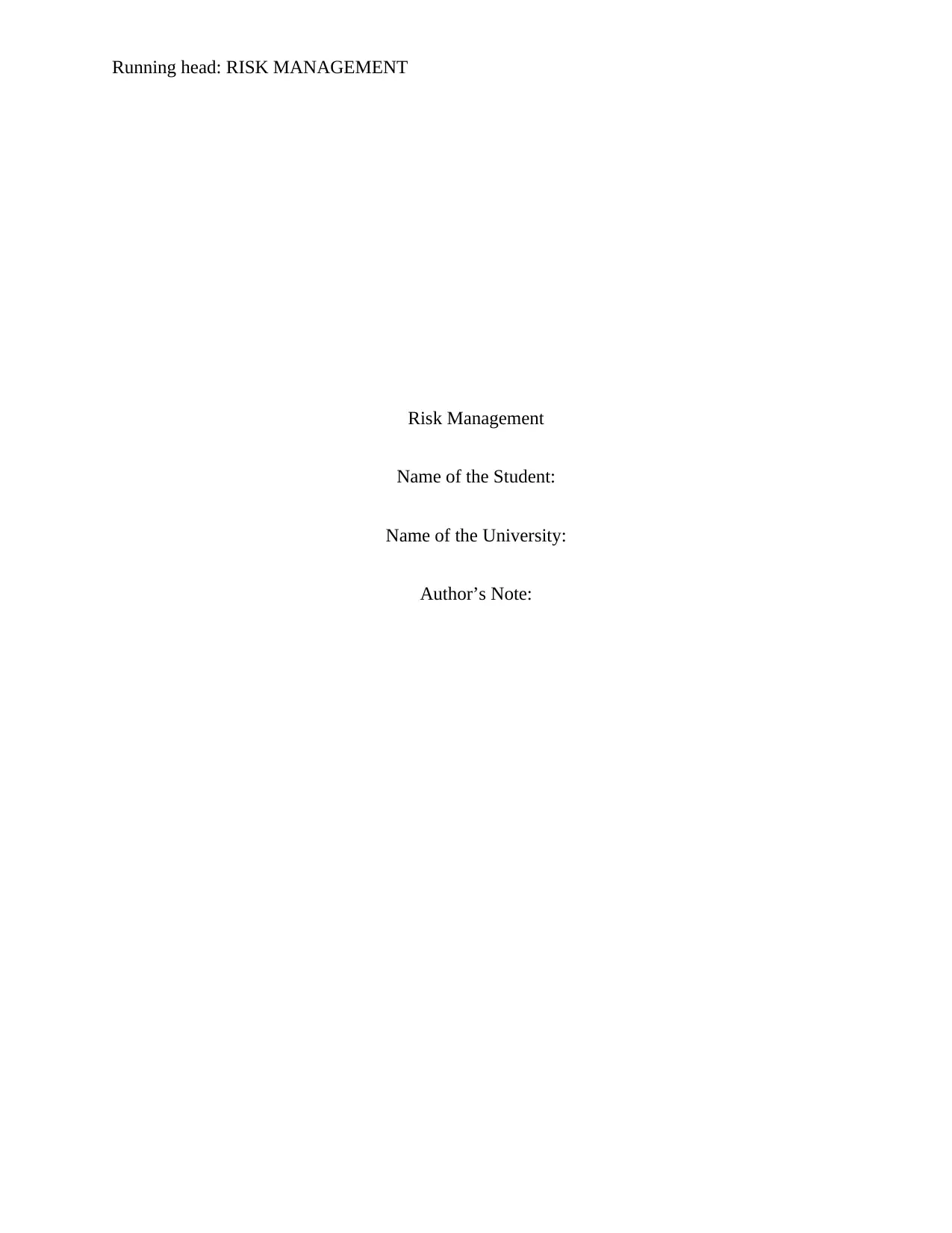
Running head: RISK MANAGEMENT
Risk Management
Name of the Student:
Name of the University:
Author’s Note:
Risk Management
Name of the Student:
Name of the University:
Author’s Note:
Paraphrase This Document
Need a fresh take? Get an instant paraphrase of this document with our AI Paraphraser
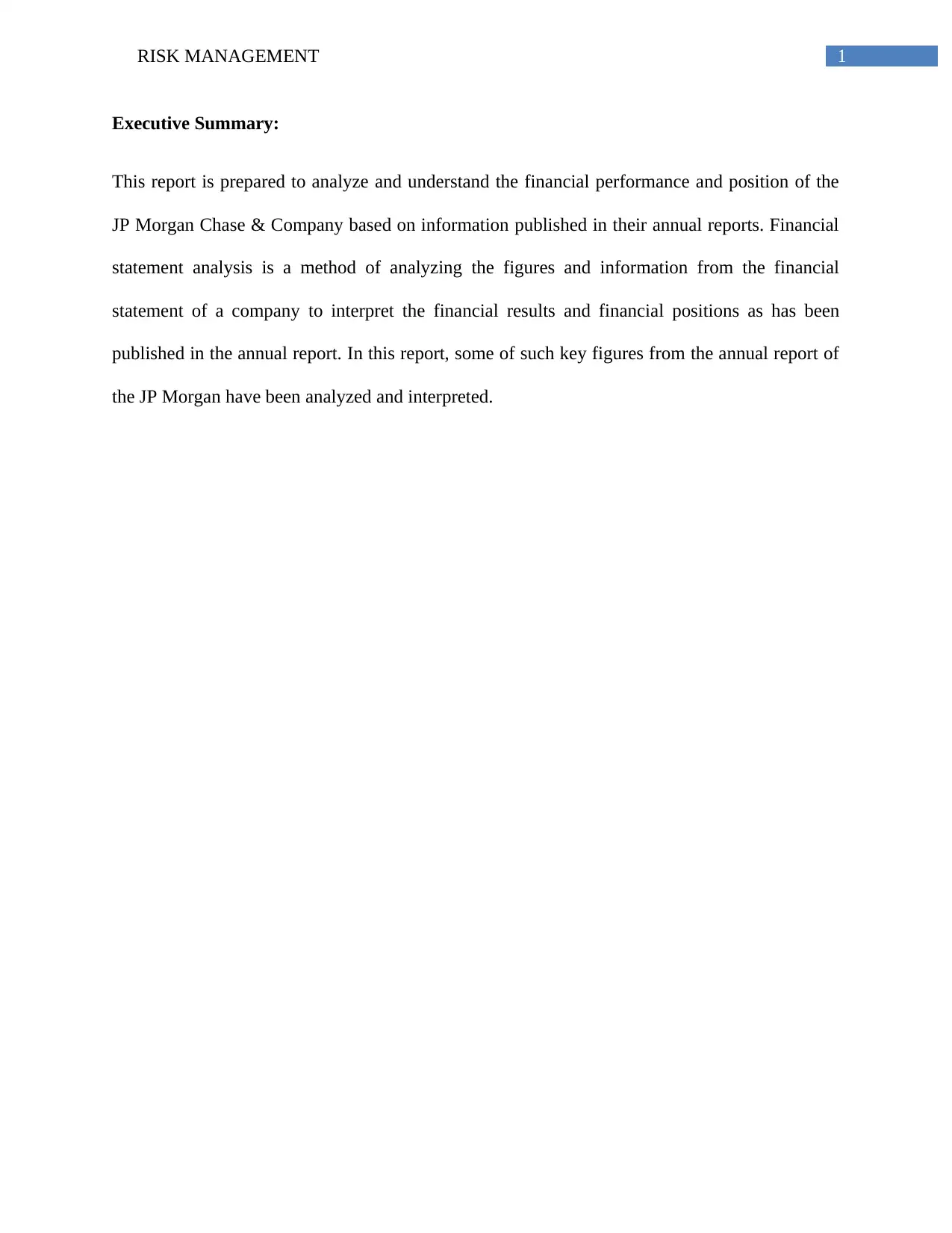
1RISK MANAGEMENT
Executive Summary:
This report is prepared to analyze and understand the financial performance and position of the
JP Morgan Chase & Company based on information published in their annual reports. Financial
statement analysis is a method of analyzing the figures and information from the financial
statement of a company to interpret the financial results and financial positions as has been
published in the annual report. In this report, some of such key figures from the annual report of
the JP Morgan have been analyzed and interpreted.
Executive Summary:
This report is prepared to analyze and understand the financial performance and position of the
JP Morgan Chase & Company based on information published in their annual reports. Financial
statement analysis is a method of analyzing the figures and information from the financial
statement of a company to interpret the financial results and financial positions as has been
published in the annual report. In this report, some of such key figures from the annual report of
the JP Morgan have been analyzed and interpreted.
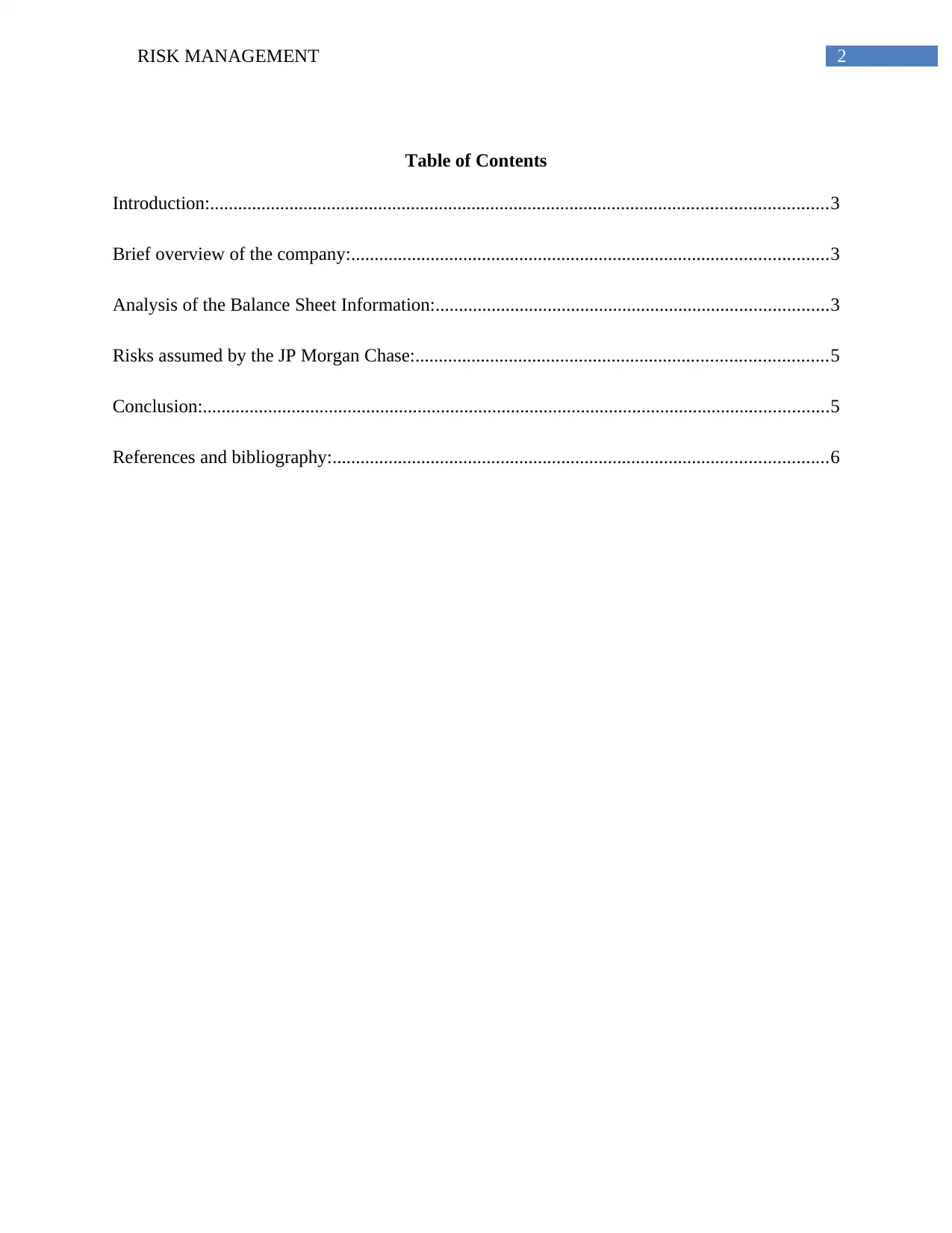
2RISK MANAGEMENT
Table of Contents
Introduction:....................................................................................................................................3
Brief overview of the company:......................................................................................................3
Analysis of the Balance Sheet Information:....................................................................................3
Risks assumed by the JP Morgan Chase:........................................................................................5
Conclusion:......................................................................................................................................5
References and bibliography:..........................................................................................................6
Table of Contents
Introduction:....................................................................................................................................3
Brief overview of the company:......................................................................................................3
Analysis of the Balance Sheet Information:....................................................................................3
Risks assumed by the JP Morgan Chase:........................................................................................5
Conclusion:......................................................................................................................................5
References and bibliography:..........................................................................................................6
⊘ This is a preview!⊘
Do you want full access?
Subscribe today to unlock all pages.

Trusted by 1+ million students worldwide
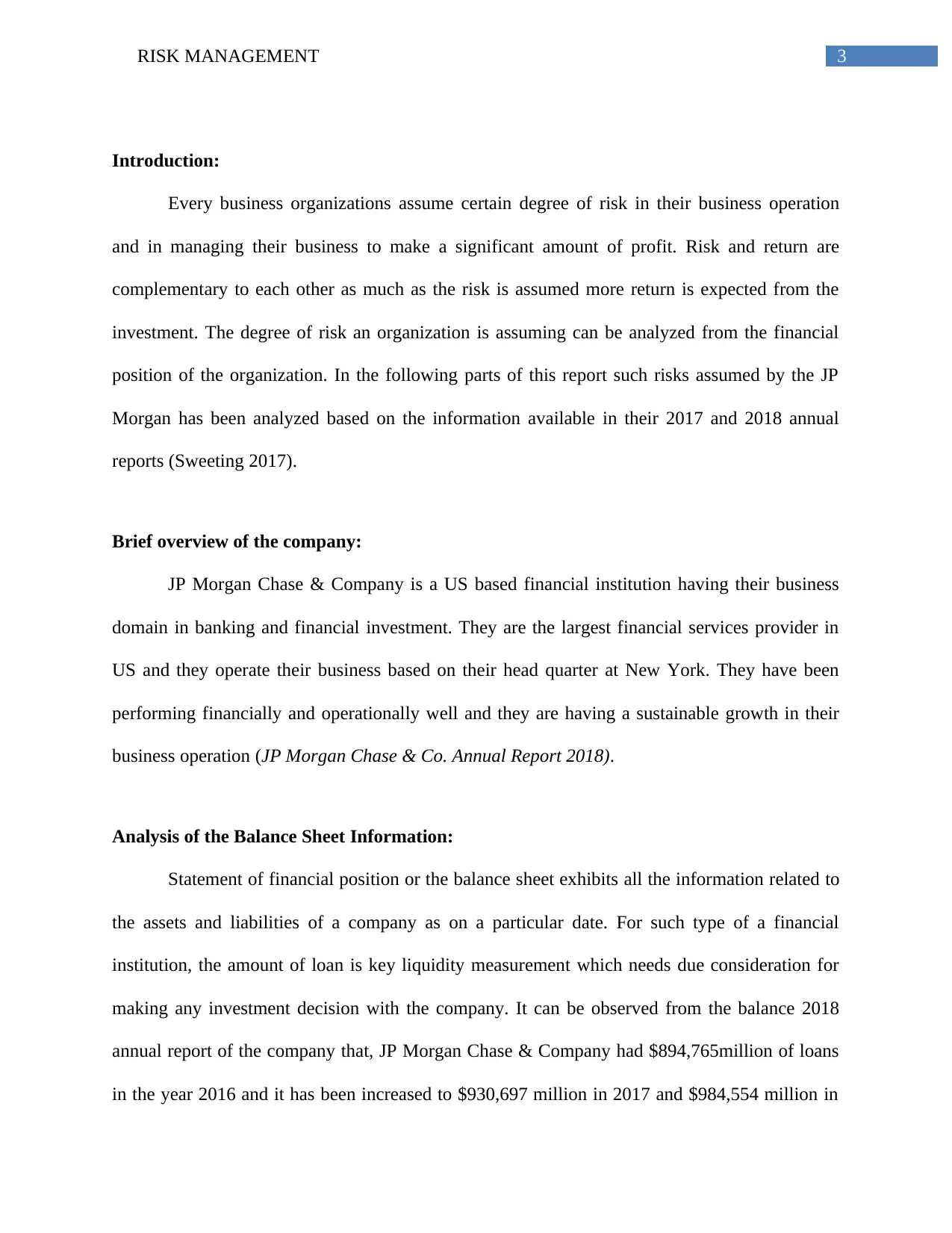
3RISK MANAGEMENT
Introduction:
Every business organizations assume certain degree of risk in their business operation
and in managing their business to make a significant amount of profit. Risk and return are
complementary to each other as much as the risk is assumed more return is expected from the
investment. The degree of risk an organization is assuming can be analyzed from the financial
position of the organization. In the following parts of this report such risks assumed by the JP
Morgan has been analyzed based on the information available in their 2017 and 2018 annual
reports (Sweeting 2017).
Brief overview of the company:
JP Morgan Chase & Company is a US based financial institution having their business
domain in banking and financial investment. They are the largest financial services provider in
US and they operate their business based on their head quarter at New York. They have been
performing financially and operationally well and they are having a sustainable growth in their
business operation (JP Morgan Chase & Co. Annual Report 2018).
Analysis of the Balance Sheet Information:
Statement of financial position or the balance sheet exhibits all the information related to
the assets and liabilities of a company as on a particular date. For such type of a financial
institution, the amount of loan is key liquidity measurement which needs due consideration for
making any investment decision with the company. It can be observed from the balance 2018
annual report of the company that, JP Morgan Chase & Company had $894,765million of loans
in the year 2016 and it has been increased to $930,697 million in 2017 and $984,554 million in
Introduction:
Every business organizations assume certain degree of risk in their business operation
and in managing their business to make a significant amount of profit. Risk and return are
complementary to each other as much as the risk is assumed more return is expected from the
investment. The degree of risk an organization is assuming can be analyzed from the financial
position of the organization. In the following parts of this report such risks assumed by the JP
Morgan has been analyzed based on the information available in their 2017 and 2018 annual
reports (Sweeting 2017).
Brief overview of the company:
JP Morgan Chase & Company is a US based financial institution having their business
domain in banking and financial investment. They are the largest financial services provider in
US and they operate their business based on their head quarter at New York. They have been
performing financially and operationally well and they are having a sustainable growth in their
business operation (JP Morgan Chase & Co. Annual Report 2018).
Analysis of the Balance Sheet Information:
Statement of financial position or the balance sheet exhibits all the information related to
the assets and liabilities of a company as on a particular date. For such type of a financial
institution, the amount of loan is key liquidity measurement which needs due consideration for
making any investment decision with the company. It can be observed from the balance 2018
annual report of the company that, JP Morgan Chase & Company had $894,765million of loans
in the year 2016 and it has been increased to $930,697 million in 2017 and $984,554 million in
Paraphrase This Document
Need a fresh take? Get an instant paraphrase of this document with our AI Paraphraser

4RISK MANAGEMENT
2018 (JP Morgan Chase & Co. Annual Report 2018). Hence, there is an average 4.90% growth
in the loans of the company. On the other hand, it can be observed that the total assets of the
company have been increased from $2,533,600 million in the year 2017 to $2,622,532million in
the year 2018. There is a marginal growth of 2.61% in the total assets of the company. As JP
Morgan is a financial institution and operating their business in the banking industry, it is
important to analyze their amount of deposits over the years. It can be observed from their
balance sheet that, they had total closing deposits of $1,443,982million in the year 2017 and it
has been increased to $1,470,666 in the year 2018. It can be observed that there was 5% increase
in amount of deposit in the year 2017 but the growth was only 1.85% in the year 2018, which
might be because of recession in the market. The most important balance sheet information is the
amount of total equity, it can be observed from the balance sheet of the company that, total
equity of the company has been increased from $255,693 million in the year 2017 to $256,515
million in the year 2018. There was a 0.59% increase in total equity in the year 2017 and 0.32%
increase in the year 2018. It can further be observed that, the profitability aspect in terms of
return on equity and earnings per share have an increasing trend over the last two years (JP
Morgan Chase & Co. Annual Report 2018).
Table 1: Key Balance Sheet Information and their Trends
2018 (JP Morgan Chase & Co. Annual Report 2018). Hence, there is an average 4.90% growth
in the loans of the company. On the other hand, it can be observed that the total assets of the
company have been increased from $2,533,600 million in the year 2017 to $2,622,532million in
the year 2018. There is a marginal growth of 2.61% in the total assets of the company. As JP
Morgan is a financial institution and operating their business in the banking industry, it is
important to analyze their amount of deposits over the years. It can be observed from their
balance sheet that, they had total closing deposits of $1,443,982million in the year 2017 and it
has been increased to $1,470,666 in the year 2018. It can be observed that there was 5% increase
in amount of deposit in the year 2017 but the growth was only 1.85% in the year 2018, which
might be because of recession in the market. The most important balance sheet information is the
amount of total equity, it can be observed from the balance sheet of the company that, total
equity of the company has been increased from $255,693 million in the year 2017 to $256,515
million in the year 2018. There was a 0.59% increase in total equity in the year 2017 and 0.32%
increase in the year 2018. It can further be observed that, the profitability aspect in terms of
return on equity and earnings per share have an increasing trend over the last two years (JP
Morgan Chase & Co. Annual Report 2018).
Table 1: Key Balance Sheet Information and their Trends

5RISK MANAGEMENT
(Source: JP Morgan Chase & Company Annual Report 2018)
Risks assumed by the JP Morgan Chase:
JP Morgan Chase is holding $400billion operational risk weighted assets by the end of
2018 fiscal year, which implies they hold almost $40billion of equity that does not exists. It can
be observed from their 2018 annual report that they are having $1,423,053 credit risk RWA
(Risk Weighted Assets), which is in a very significant level. Fluctuation in the LIBOR creates
the interest rate risk for them and a consolidated value of $175 million can be considered as their
interest rate risk, which is incurred by them to hedge the fluctuation in the interest rate and
foreign exchange losses (Miller 2013). All the banks and financial institutions have to assume
certain level of risks in continuing their business operations, JP Morgan is also having such risks,
and they have efficient strategies to hedge against those risks (JP Morgan Chase & Co. Annual
Report 2018).
Conclusion:
From the above discussion and analysis, it can be concluded that, they are having a good
financial position and a good sustainability in their business but their recent business strategies
lead to a decrease in the net worth or the total equity of the company. They are still having a
good profitability and a sustainable growth in their profitability. They are assuming a
considerable level of operational risks but they are having efficient strategies to hedge against
those risks as well.
(Source: JP Morgan Chase & Company Annual Report 2018)
Risks assumed by the JP Morgan Chase:
JP Morgan Chase is holding $400billion operational risk weighted assets by the end of
2018 fiscal year, which implies they hold almost $40billion of equity that does not exists. It can
be observed from their 2018 annual report that they are having $1,423,053 credit risk RWA
(Risk Weighted Assets), which is in a very significant level. Fluctuation in the LIBOR creates
the interest rate risk for them and a consolidated value of $175 million can be considered as their
interest rate risk, which is incurred by them to hedge the fluctuation in the interest rate and
foreign exchange losses (Miller 2013). All the banks and financial institutions have to assume
certain level of risks in continuing their business operations, JP Morgan is also having such risks,
and they have efficient strategies to hedge against those risks (JP Morgan Chase & Co. Annual
Report 2018).
Conclusion:
From the above discussion and analysis, it can be concluded that, they are having a good
financial position and a good sustainability in their business but their recent business strategies
lead to a decrease in the net worth or the total equity of the company. They are still having a
good profitability and a sustainable growth in their profitability. They are assuming a
considerable level of operational risks but they are having efficient strategies to hedge against
those risks as well.
⊘ This is a preview!⊘
Do you want full access?
Subscribe today to unlock all pages.

Trusted by 1+ million students worldwide
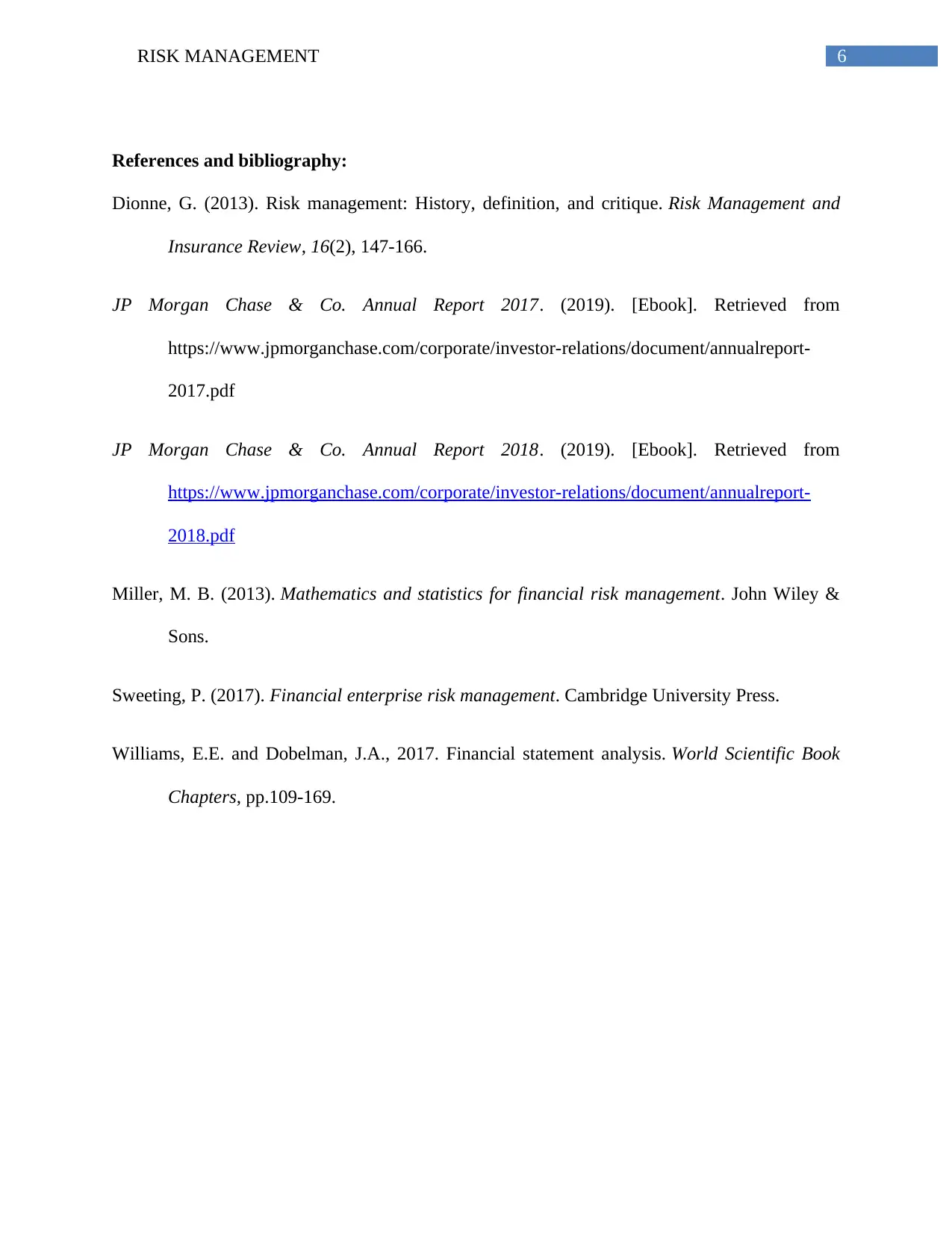
6RISK MANAGEMENT
References and bibliography:
Dionne, G. (2013). Risk management: History, definition, and critique. Risk Management and
Insurance Review, 16(2), 147-166.
JP Morgan Chase & Co. Annual Report 2017. (2019). [Ebook]. Retrieved from
https://www.jpmorganchase.com/corporate/investor-relations/document/annualreport-
2017.pdf
JP Morgan Chase & Co. Annual Report 2018. (2019). [Ebook]. Retrieved from
https://www.jpmorganchase.com/corporate/investor-relations/document/annualreport-
2018.pdf
Miller, M. B. (2013). Mathematics and statistics for financial risk management. John Wiley &
Sons.
Sweeting, P. (2017). Financial enterprise risk management. Cambridge University Press.
Williams, E.E. and Dobelman, J.A., 2017. Financial statement analysis. World Scientific Book
Chapters, pp.109-169.
References and bibliography:
Dionne, G. (2013). Risk management: History, definition, and critique. Risk Management and
Insurance Review, 16(2), 147-166.
JP Morgan Chase & Co. Annual Report 2017. (2019). [Ebook]. Retrieved from
https://www.jpmorganchase.com/corporate/investor-relations/document/annualreport-
2017.pdf
JP Morgan Chase & Co. Annual Report 2018. (2019). [Ebook]. Retrieved from
https://www.jpmorganchase.com/corporate/investor-relations/document/annualreport-
2018.pdf
Miller, M. B. (2013). Mathematics and statistics for financial risk management. John Wiley &
Sons.
Sweeting, P. (2017). Financial enterprise risk management. Cambridge University Press.
Williams, E.E. and Dobelman, J.A., 2017. Financial statement analysis. World Scientific Book
Chapters, pp.109-169.
1 out of 7
Related Documents
Your All-in-One AI-Powered Toolkit for Academic Success.
+13062052269
info@desklib.com
Available 24*7 on WhatsApp / Email
![[object Object]](/_next/static/media/star-bottom.7253800d.svg)
Unlock your academic potential
Copyright © 2020–2025 A2Z Services. All Rights Reserved. Developed and managed by ZUCOL.




